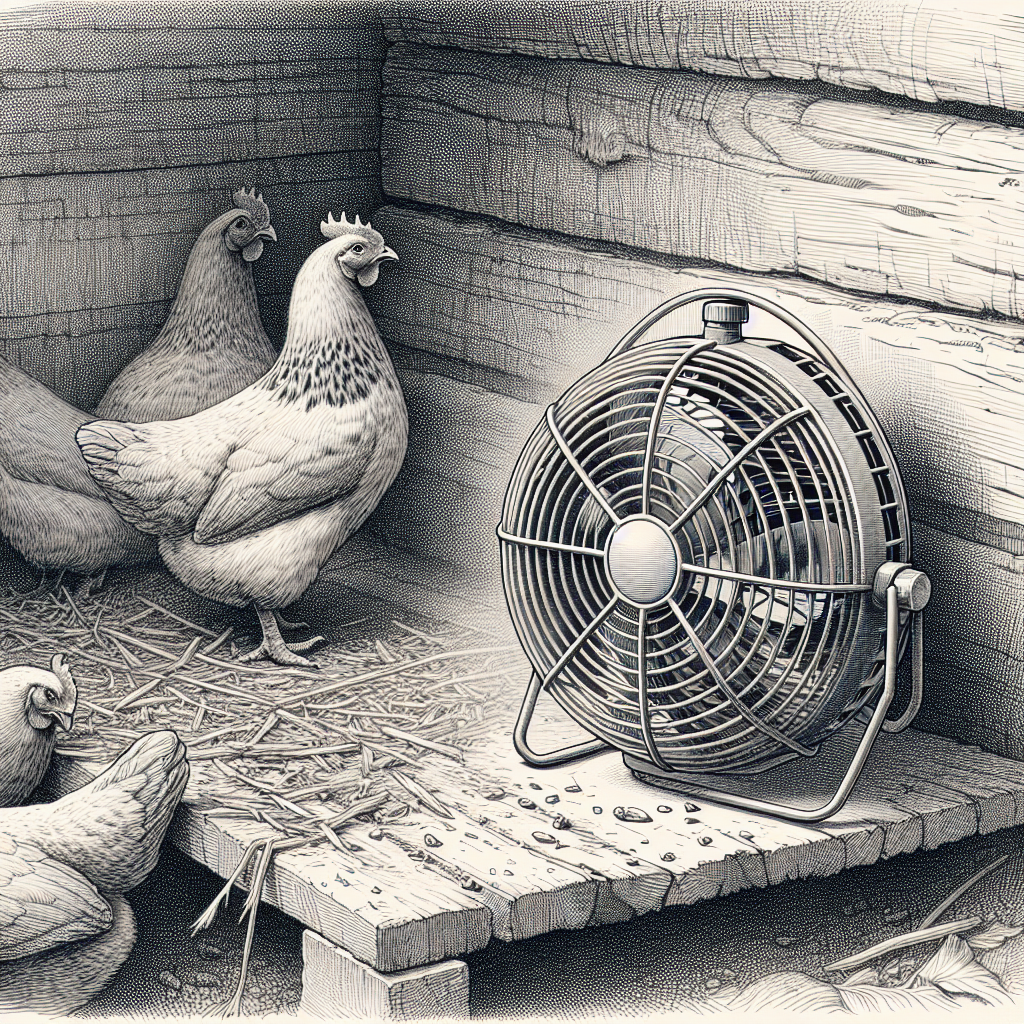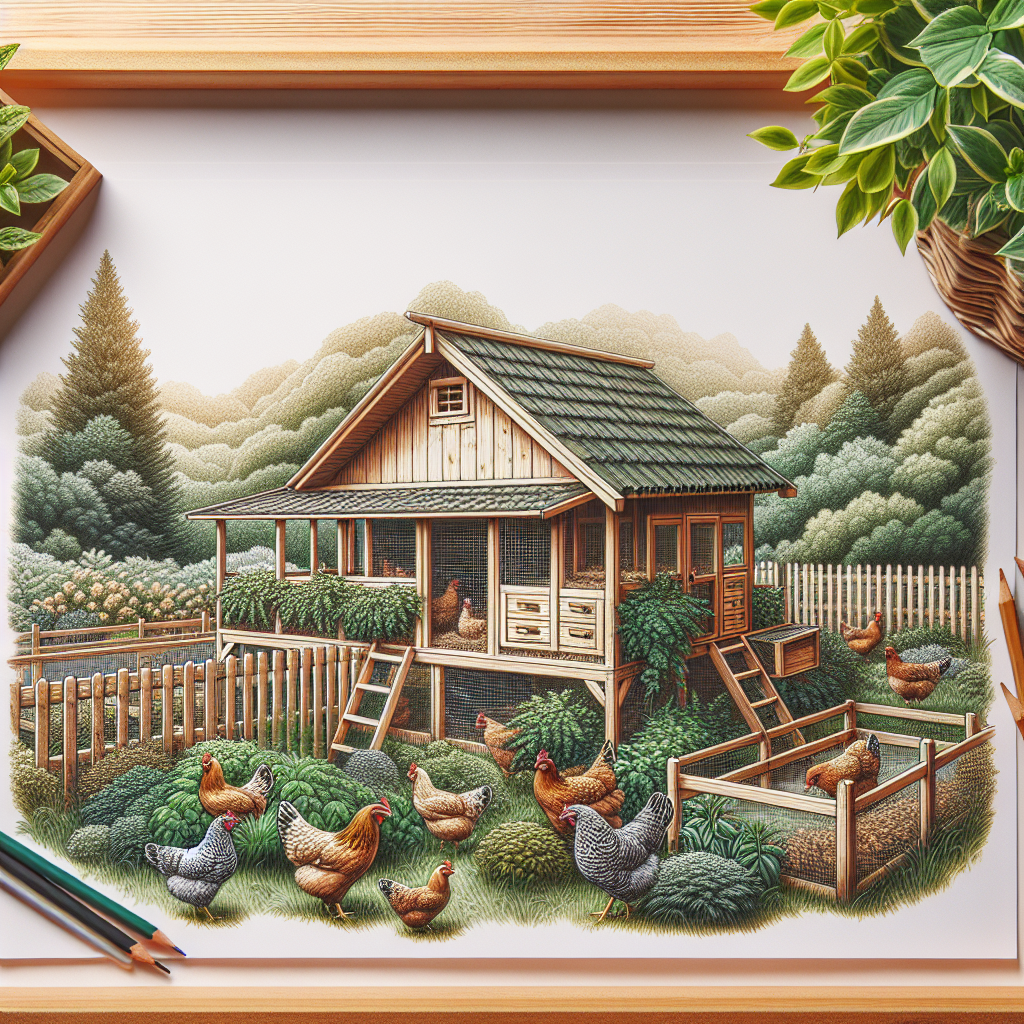If you’re a poultry owner, you know how important it is to ensure the well-being of your flock. One crucial aspect of keeping your chickens healthy is maintaining optimal humidity and ventilation in their coop. By creating a comfortable and breathable environment, you can prevent respiratory issues that can be detrimental to their health. In this article, we will explore some effective strategies to achieve the ideal conditions inside the coop, ensuring happy and thriving chickens.
Understanding the Importance of Humidity and Ventilation in the Coop
When it comes to raising chickens, ensuring optimal humidity and ventilation in their coop is crucial for their overall health and well-being. Humidity refers to the amount of moisture in the air, while ventilation refers to the circulation of fresh air within the space. These two factors are closely related and play a significant role in preventing respiratory issues in chickens.
The impact of humidity and ventilation on chicken health
Humidity and ventilation directly affect the respiratory health of chickens. Poor humidity control can lead to the buildup of moisture, which creates a favorable environment for bacterial and fungal growth. Additionally, excessive moisture can make the air feel heavy and can cause respiratory distress in chickens.
Insufficient ventilation, on the other hand, can lead to the accumulation of harmful gases such as ammonia and carbon dioxide, as well as dust and dander. These airborne pollutants can irritate the respiratory system of chickens and contribute to the development of respiratory diseases.
Common respiratory issues in chickens caused by poor humidity and ventilation
When humidity and ventilation are not properly managed in the coop, chickens can be prone to respiratory issues. Some common respiratory problems caused by poor humidity and ventilation include:
- Respiratory infections: Bacterial and viral infections can spread more easily in a damp and poorly ventilated environment. Chickens may develop symptoms such as coughing, sneezing, nasal discharge, and difficulty breathing.
- Fungal infections: Excessive moisture can lead to the growth of fungi, such as Aspergillus, which can cause respiratory infections in chickens. Symptoms may include labored breathing, loss of appetite, and weakness.
- Dust-related respiratory issues: Poor ventilation can result in the accumulation of dust and particles in the air, which can irritate the respiratory system of chickens and lead to coughing, wheezing, and eye irritation.
The benefits of maintaining optimal humidity and ventilation in the coop
Maintaining optimal humidity and ventilation in the coop offers several benefits for both the chickens and the poultry keeper:
- Improved respiratory health: By providing a well-ventilated and properly humidified environment, you can reduce the risk of respiratory issues in chickens, promoting healthier and more active birds.
- Prevention of moisture-related problems: Proper humidity control helps prevent the buildup of excess moisture, which can cause mold growth, structural damage to the coop, and overall poor hygiene.
- Enhanced comfort: Optimal humidity and ventilation create a more comfortable environment for the chickens, ensuring they can thrive and exhibit natural behaviors.
- Reduced odors and ammonia levels: Good ventilation helps to remove odors and eliminate harmful gases like ammonia that can be generated by chicken manure. This not only benefits the chickens but also improves the overall air quality in and around the coop.
Measuring and Maintaining Humidity Levels
Using a hygrometer to monitor humidity
One of the essential tools for monitoring humidity levels in the coop is a hygrometer. A hygrometer is a device that measures the moisture content in the air. Place it in a central location within the coop, away from direct sunlight or water sources, to obtain accurate readings.
Ideal humidity range for a chicken coop
The ideal humidity range for a chicken coop should be between 40% and 70%. Higher humidity levels can promote bacterial and fungal growth, while lower levels can cause respiratory distress in chickens. It’s crucial to consistently monitor and maintain humidity within this range to ensure optimal conditions.
Methods to increase humidity in the coop
If the humidity in the coop falls below the optimal range, some methods can help increase humidity levels. These include:
- Providing shallow water dishes: Placing shallow water dishes inside the coop can increase moisture evaporation and raise humidity levels.
- Using a humidifier or misting system: In dry climates, a humidifier or misting system can be used to add moisture to the air inside the coop. This is especially useful during winter months when humidity levels tend to drop.
Methods to decrease humidity in the coop
On the other hand, if the humidity in the coop is consistently above the optimal range, measures should be taken to decrease it. Some effective methods to decrease humidity include:
- Increasing ventilation: Improving airflow by opening windows, adding vents, or using an exhaust fan can help reduce excess moisture in the coop.
- Adding absorbent materials: Placing absorbent materials, such as straw or wood shavings, on the coop floor can help absorb excess moisture and prevent its accumulation.
Ensuring Proper Ventilation
Importance of ventilation in preventing respiratory issues
Proper ventilation is crucial for maintaining good air quality in the coop and preventing respiratory issues in chickens. Adequate airflow helps to remove dust, airborne pathogens, excess heat, and harmful gases that can accumulate inside the coop.
Identifying signs of poor ventilation
It’s essential to watch for signs of poor ventilation in the coop. Some common signs to look out for include:
- Foul odors: A strong, unpleasant odor inside the coop indicates poor ventilation and the presence of ammonia.
- Condensation: Moisture buildup on coop surfaces, such as windows or walls, suggests inadequate airflow and excessive humidity.
- Excessive dust or cobwebs: Dust and cobwebs can accumulate in a poorly ventilated coop due to stagnant air, leading to respiratory issues in chickens.
Positioning vents and windows for optimal air circulation
To ensure proper air circulation, vents and windows should be strategically placed within the coop. Vents should be positioned near the ceiling to allow warm, moist air to escape while drawing in fresh air from outside. Windows should be situated to promote cross ventilation and provide natural light.
Choosing the right ventilation system
Depending on the size and design of your coop, you may choose to install a ventilation system to ensure consistent airflow. There are various options available, including passive vents, exhaust fans, or a combination of both. Consider factors such as cost, energy efficiency, noise levels, and ease of installation when selecting a ventilation system.
Managing Temperature and Humidity for Chickens’ Well-being
Relationship between temperature and humidity
Humidity and temperature are closely linked, and managing both factors in harmony is essential for the well-being of chickens. High humidity levels can make chickens more sensitive to heat, while low humidity can lead to increased heat loss from their body, making them susceptible to cold stress.
Maintaining a comfortable temperature range for chickens
The ideal temperature for chickens typically ranges between 65°F and 75°F (18°C and 24°C). By maintaining this temperature range, you can help ensure optimal comfort and minimize the risk of heat or cold stress.
Strategies for controlling temperature and humidity simultaneously
To simultaneously control both temperature and humidity levels in the coop, consider the following strategies:
- Insulation: Proper insulation can help regulate temperature and prevent significant fluctuations. It can also reduce the amount of moisture that enters or leaves the coop, assisting in humidity control.
- Natural ventilation: Utilize natural ventilation methods, such as windows, vents, and cross ventilation, to help regulate both temperature and humidity. Opening windows and vents during cooler periods and adjusting them accordingly can provide the desired balance.
- Artificial temperature and humidity control: In extreme climates, it may be necessary to incorporate additional measures, such as heaters or cooling systems, to maintain optimal temperature and humidity levels.
Preventing Moisture Build-up and Mold Growth
Effects of excessive moisture and mold on chicken health
Excessive moisture and mold growth in the coop can have detrimental effects on chicken health. Chickens exposed to mold spores and excess moisture are at an increased risk of developing respiratory issues and infections. Additionally, mold can release harmful mycotoxins, which can negatively impact the overall well-being of the chickens.
Identifying potential sources of moisture in the coop
To effectively prevent moisture buildup, it’s essential to identify potential sources of moisture in the coop. Some common sources include:
- Water leakage: Any leaks from plumbing, roofs, or waterers can lead to excess moisture in the coop.
- Inadequate drainage: Poorly draining floors or lack of proper gutter systems can allow water to accumulate around the coop, contributing to increased moisture levels.
- Wet bedding: Bedding materials that are not regularly replaced or are excessively wet can contribute to moisture buildup.
Preventing moisture build-up through proper insulation
Proper insulation plays a vital role in preventing moisture build-up in the coop. Insulating the walls, roof, and floor can help maintain a controlled environment, reducing the potential for condensation and excess moisture.
Dealing with mold growth in the coop
If mold growth is observed in the coop, immediate action should be taken to address the issue. Steps to deal with mold growth include:
- Remove affected materials: Discard any bedding, feed, or other porous materials that have been affected by mold.
- Clean and disinfect: Thoroughly clean and disinfect the coop, paying special attention to areas prone to mold growth. Use a mixture of vinegar and water or a commercial disinfectant.
- Improve ventilation: Enhance airflow within the coop to reduce excess moisture and prevent future mold growth.
- Repair leaks: Address any sources of water leakage promptly to prevent the reoccurrence of mold.
Utilizing Natural Ventilation Methods
Utilizing the coop’s design to maximize natural airflow
The design of the coop can greatly impact the natural airflow within the space. Consider the following design elements to maximize natural ventilation:
- Elevated coop: Elevating the coop slightly allows for better airflow beneath the structure, preventing stagnant air and excess moisture accumulation.
- Sloped roof: A sloped or peaked roof design allows warm, moist air to rise and escape, while fresh air is drawn in through vents or windows.
- South-facing windows: Positioning windows on the southern side of the coop allows for natural sunlight and airflow, aiding in moisture control and reducing the need for artificial lighting.
Importance of windows and vents for natural ventilation
Windows and vents are essential for natural ventilation in the coop. Windows should be placed strategically to allow for cross ventilation and natural light. Vents, such as gable vents or soffit vents, should be installed near the roofline to facilitate the escape of warm, moist air.
Creating openings for cross ventilation
Cross ventilation is crucial for maintaining good air quality and controlling humidity levels. To create effective cross ventilation, ensure windows and vents are positioned to allow air to flow from one side of the coop to the other. This helps remove stagnant air and promotes the circulation of fresh air.
Utilizing landscaping for optimal air circulation
Landscaping around the coop can also contribute to optimal air circulation. Well-placed trees or shrubs can provide shade, block strong winds, and create a more comfortable microclimate within the coop area.
Installing Artificial Ventilation Systems
Types of artificial ventilation systems
When natural ventilation alone is insufficient, installing artificial ventilation systems can help maintain optimal airflow and humidity levels. Some common types of systems include:
- Exhaust fans: These fans remove stale air and moisture from the coop, promoting fresh airflow.
- Tube ventilation: Tube ventilation systems circulate fresh air evenly throughout the coop, ensuring consistent air quality.
- Combination systems: Depending on the coop’s size and specific requirements, a combination of different ventilation systems may be used to achieve the desired results.
Choosing the right size and capacity for the coop
When selecting an artificial ventilation system, it’s crucial to consider the size and capacity of the coop. Choose a system that can effectively circulate the air within the entire space, ensuring proper ventilation for the number of chickens being housed.
Installation and maintenance considerations
Proper installation of artificial ventilation systems is essential for their optimal functioning. Follow the manufacturer’s instructions and recommendations, ensuring that the system is installed correctly and securely. Regular maintenance, such as cleaning or replacing filters, is also important to ensure continued effectiveness and to prevent clogs or malfunctions.
Addressing Common Concerns and Challenges
Preventing drafts while ensuring proper air exchange
While it’s important to provide adequate ventilation, it’s equally vital to prevent drafts within the coop. Excessive drafts can cause cold stress in chickens, especially during colder months. To address this concern, place vents and windows strategically to promote proper air exchange without creating direct drafts on the chickens. Additionally, insulating the coop can regulate temperature and prevent drafts.
Balancing humidity during different seasons and climate changes
Humidity levels may vary with different seasons and climate changes. During colder months, humidity tends to drop, while humid conditions can be a challenge during hot and humid seasons. Monitoring humidity levels closely, using appropriate methods such as water dishes or humidifiers, and adjusting ventilation accordingly can help maintain optimal humidity throughout the year.
Preventing the spread of diseases in well-ventilated coops
While good ventilation helps prevent respiratory issues in chickens, it’s important to remember that diseases can still be transmitted through contaminated surfaces or direct contact. Implement proper biosecurity measures, such as regular cleaning and disinfection, limiting visitors, and preventing contact with wild birds or other poultry, to minimize the spread of diseases.
Potential energy-efficiency measures for ventilation
Achieving optimal humidity and ventilation doesn’t have to come at the cost of excessive energy consumption. Consider energy-efficient options when selecting ventilation systems, such as fans with adjustable speeds or timers. Additionally, maximizing natural ventilation methods can help reduce the reliance on artificial systems and save energy.
Regular Maintenance and Cleaning
Importance of regular coop maintenance
Regular maintenance is crucial for the overall health and well-being of the chickens. Maintaining a clean and well-maintained coop prevents the accumulation of waste materials, excess moisture, and potential sources of contamination.
Removing excess moisture and waste materials
Regularly remove excess moisture from the coop, whether from spills, leaks, or wet bedding. Ensure proper drainage systems are in place and promptly address any sources of moisture to prevent mold growth. Clean and remove waste materials, such as manure or old bedding, to maintain a hygienic environment.
Cleaning and disinfecting ventilation systems
Ventilation systems, whether natural or artificial, should be regularly cleaned and inspected for proper functioning. Remove any dust, cobwebs, or debris that may obstruct airflow. Periodically disinfect the ventilation system to eliminate potential pathogens.
Seeking Professional Advice and Support
Consulting with poultry experts or veterinarians
If you’re unsure about maintaining optimal humidity and ventilation in your chicken coop, consider consulting with poultry experts or veterinarians. They can provide advice tailored to your specific situation, helping you address any concerns or challenges you may be facing.
Joining local or online communities for advice and guidance
Joining local or online communities of poultry keepers can also be invaluable for gathering advice and guidance. Fellow chicken enthusiasts often share their experiences and can offer tips on maintaining proper humidity and ventilation in the coop.
Considering professional assistance for ventilation system installation
If you decide to install an artificial ventilation system but lack the necessary expertise, consider hiring professionals for installation. They can ensure that the system is properly installed, integrated with the existing coop, and meets both safety and regulatory requirements.
Maintaining optimal humidity and ventilation in your chicken coop is a crucial aspect of poultry care. By understanding the importance of these factors and taking appropriate measures, you can create a healthy and comfortable environment for your feathered friends, reducing the risk of respiratory issues and promoting their overall well-being.




